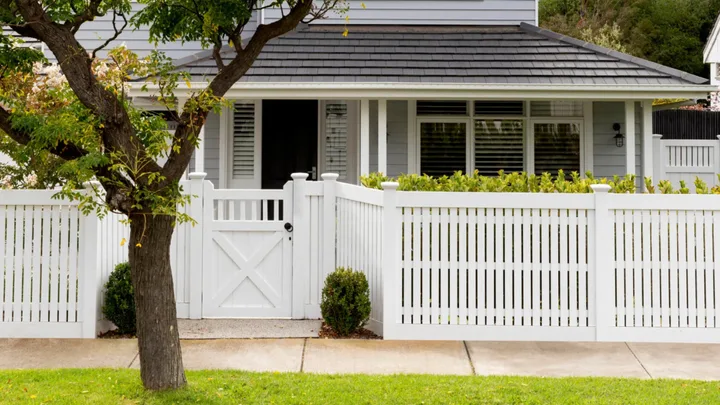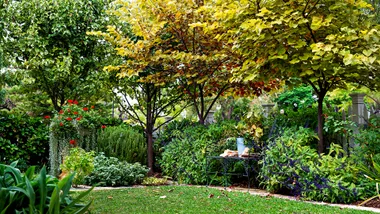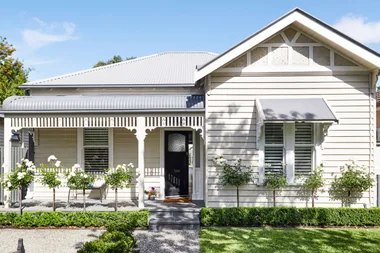There’s a lot riding on a front fence. Not only is it the first thing people see when they arrive at your place, but it can really affect the way you experience your property – making it feel either open and welcoming to neighbours, or quiet and secluded, like your very own private retreat. It’s important for a fence to provide privacy and security, but it’s equally important for it to match the look and feel of your home. So how do you decide?
A heritage home, such as a Victorian cottage or Federation home work best with either a timber picket fence or a fence made from wrought iron, while a modern brick house would look best with either a brick, aluminium or composite fence. The idea is to look for a fence that compliments your home while taking considerations such as the climate, the level of upkeep you’re willing to accept and your budget, of course.
Here we run through 8 amazing front fence ideas featuring timber, brick and the affordable all-rounder: aluminium.
8 front fence ideas to inspire

Timber picket fence
Perfect for a period home
When you think of fences, the first type of fence that probably comes to mind is a picket fence. A picket fence is traditionally made from evenly spaced timber boards attached to horizontal rails that dates back to America’s earliest colonial period (from about the 1620s to 1720s). The tops of the timber boards were originally pointed to deter intruders, but modern versions are simply decorative.
A bespoke picket fence with hand-carved finials gives this Federation home a delightful, old-world charm.

Modern picket fence
For contemporary homes with a timeless design
After many years living in New York, the owners of this newly built Melbourne home were inspired to build a home just like the grand houses in The Hamptons, a popular holiday destination in the US. White picket fences are one of the key elements of the style.
This square picket fence features simple straight lines and very little ornamentation or flair, resulting in a look that is at once timeless, yet modern.

Brick fence
Warm and strong
Opt for brick if you’re looking for a timeless, durable option that will add warmth and structure to your home’s exterior. Brick doesn’t have many downsides, but it is a relatively expensive option both in material and labour costs. But take heart, brick is versatile and can work alongside other more affordable materials like aluminium to create a cohesive, yet cost-effective fence.
Take style notes from this Brisbane home which combines a modern aluminium picket fence with a panel made from reclaimed red bricks. Passersby often stop to ask about the red bricks, which were sourced from a recycle yard in NSW.

Concrete fencing
The ultimate in privacy and seclusion
Concrete is one of the most widely used building materials in Australia, and today, this sturdy material is becoming a design feature in its own right, rather than something to be hide. The best match for a house that heroes concrete is, of course, a concrete wall. A concrete fence provides plenty of privacy and also creates a sound barrier, excellent for homes located on a busy road. Pre-cast concrete fencing options have made this option relatively affordable, and these products can be customised with cut-outs and curves and to suit your home.
A fresh coat of paint in Dulux Colorbond Surfmist Half and stone detailing at the entryway of this renovated coastal home completely refreshed the look of this 80s-era build.

Stone fencing
Textural and inviting
It may seem counterintuitive, but stone can really take a strong, fortress-like structure like a fence and make it feel warm and inviting. And while a front fence made entirely of stone is uncommon, using even just a touch of stone in strategic places (like either side of the front gate) can have a huge impact.
At this newly built Brisbane home, stone detailing adds to the coastal, private vibe of a concrete fence paired with a slatted, automated aluminium driveway gate.

Aluminium fencing
The affordable all-rounder
Aluminium is tough, affordable and versatile – making it a great choice for almost any type of Australian home. It is corrosion and rust-resistant, making it an exceptional choice for coastal areas. It won’t attract termites and the powder-coated surfaces requires very little maintenance or upkeep. Aluminium is also lightweight and easy to mould to almost any kind of application. DIY aluminium fence panels can be custom ordered from Bunnings, with prices starting at about $300 per panel.
A white aluminium fence with an automated sliding gate lends a modern touch to the exterior of this classic Queenslander.

Composite fencing
The best of wood without the woes
Composite fencing is made from a combination of wood fibres (or sawdust) and plastic – resulting in a durable, weatherproof fence that has all of the aesthetic qualities of wood without any of wood’s limitations (rot, splitting and upkeep, to name a few).
Composite fencing is available in a range of colours and styles to suit almost any type of home, whether it’s a modern farmhouse or a mixed-materials contemporary home.

Go green
Fix a tired fence without lifting a hammer
Got a lacklustre front fence that is structurally sound and not quite worth replacing? Give it a revamp with plants. There are two main options you can go with here: a classic, manicured hedge or a fast-growing climbing plant.
A hedge will add extra privacy, shade and a sound buffer as seen in this Hervey Bay oasis, while a climber like Boston ivy will quickly conceal a sad or crumbling fence with minimal fuss.
 Photography: Martina Gemmola | Styling: Jessica Bellef
Photography: Martina Gemmola | Styling: Jessica Bellef


